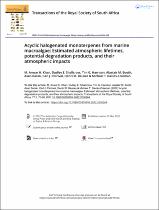Acyclic halogenated monoterpenes from marine macroalgae: Estimated atmospheric lifetimes, potential degradation products, and their atmospheric impacts
Date
2022Author
Khan, Md Anwar Hossain
Shallcross, Dudley E.
Harrison, Tim G.
Metadata
Show full item recordAbstract
The selected acyclic halogenated monoterpenes derived from red macroalgae are investigated in terms of
their isolation, their reactions with oxidants (ozone, OH radical) and the impacts of the first-generation
oxidation products on the atmosphere. The yields of these monoterpenes from marine algae are small
and highly variable (0.01–6.7%), the fractions can then enter the atmosphere through different
meteorologically driven processes. The loss of the monoterpenes is mostly driven by OH radical,
however, 1,6-dibromo-2,7-dichloro-3,7-dimethyl-oct-3-ene and 4-bromo-8-chloro-3,7-dimethyl-octa-2,6-
dienal undergo significant loss via reaction with ozone (>50%). The atmospheric lifetimes of the
compounds investigated range from ca. 1.5–10 h. Given their short lifetimes, these compounds can be
rapidly oxidised to form a range of stable compounds. The investigation of first-generation products
from the OH-initiated oxidation of 5,6-dichloro-2-dichloromethyl-6-methyl-octa-1,3,7-triene, 1,6-
dibromo-2,7-dichloro-3,7-dimethyl-oct-3-ene and 4-bromo-8-chloro-3,7-dimethyl-octa-2,6-dienal
showed the formation of stable organic hydroperoxides, alcohols and carbonyl compounds which can
have significant impact on cloud condensation nuclei as contributors of secondary organic aerosols.
Release of free halogen can occur from subsequent product oxidation, notably photolysis of carbonyl
type species and these are briefly considered.

